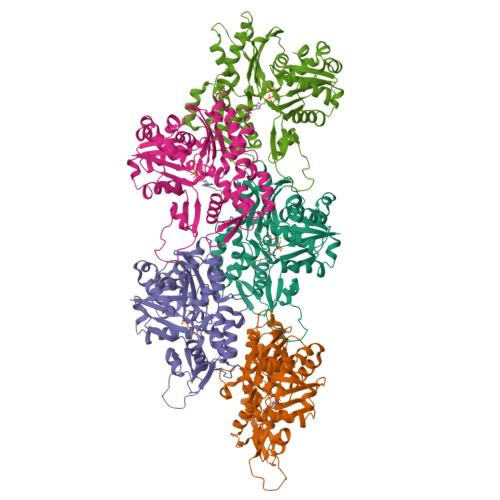Structural basis of rapid actin dynamics in the evolutionarily divergent Leishmania parasite.
Kotila, T., Wioland, H., Selvaraj, M., Kogan, K., Antenucci, L., Jegou, A., Huiskonen, J.T., Romet-Lemonne, G., Lappalainen, P.(2022) Nat Commun 13: 3442-3442
- PubMed: 35705539
- DOI: https://doi.org/10.1038/s41467-022-31068-y
- Primary Citation of Related Structures:
7Q8B, 7Q8C, 7Q8S - PubMed Abstract:
Actin polymerization generates forces for cellular processes throughout the eukaryotic kingdom, but our understanding of the 'ancient' actin turnover machineries is limited. We show that, despite > 1 billion years of evolution, pathogenic Leishmania major parasite and mammalian actins share the same overall fold and co-polymerize with each other. Interestingly, Leishmania harbors a simple actin-regulatory machinery that lacks cofilin 'cofactors', which accelerate filament disassembly in higher eukaryotes. By applying single-filament biochemistry we discovered that, compared to mammalian proteins, Leishmania actin filaments depolymerize more rapidly from both ends, and are severed > 100-fold more efficiently by cofilin. Our high-resolution cryo-EM structures of Leishmania ADP-, ADP-Pi- and cofilin-actin filaments identify specific features at actin subunit interfaces and cofilin-actin interactions that explain the unusually rapid dynamics of parasite actin filaments. Our findings reveal how divergent parasites achieve rapid actin dynamics using a remarkably simple set of actin-binding proteins, and elucidate evolution of the actin cytoskeleton.
Organizational Affiliation:
Institute of Biotechnology and Helsinki Institute of Life Science, University of Helsinki, P.O. Box 56, 00014, Helsinki, Finland.





















